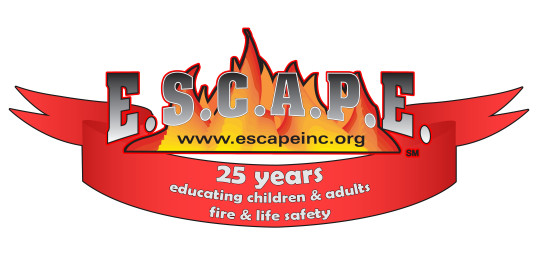These 3 common types of fire extinguishers (ABC) are often found in homes and businesses. Most home improvement stores carry multipurpose fire extinguishers that cover Class A through Class C.
 For use with ordinary materials like cloth, wood and paper.
For use with ordinary materials like cloth, wood and paper.
 For use with combustible and fammable liquids like grease, gasoline, oil and oil-based paints.
For use with combustible and fammable liquids like grease, gasoline, oil and oil-based paints.
 For use with electrical equipment like appliances, tools, or other equipment that is plugged in.
For use with electrical equipment like appliances, tools, or other equipment that is plugged in.
Listen to this morning’s interview on the Morning Show when Ken Lanphear interviews Lt. Michael McLeieer, founder and President of E.S.C.A.P.E. in studio on WKZO AM 590 and FM 106.9.
Help people decide when to use a fire extinguisher
Fire extinguishers can be helpful on a small fire. Consider providing a checklist to help people prepare to use a fire extinguisher on a potential fire.
For example:
- Have I alerted others in the building that there’s a fire?
- Has someone called the fire department?
- Am I physically able to use a fire extinguisher?
- Is the fire small and contained in a single object (like a pan or a wastebasket)?
- Am I safe from the fire’s toxic smoke?
- Do I have a clear escape route?
Use a fire extinguisher when all of these questions are answered “yes.” If you’re unsure about whether or not it’s safe to use a fire extinguisher, and for all other situations, alert others, leave the building, and call 911 from a mobile or neighbor’s phone. It is not recommended that children use fire extinguishers.
Teach people how to use a fire extinguisher
When operating a fire extinguisher, tell residents to remember the word PASS:
- Pull the pin. Hold the extinguisher with the nozzle pointing away from you and release the locking mechanism.
- Aim low. Point the extinguisher at the base of the fire.
- Squeeze the lever slowly and evenly.
- Sweep the nozzle from side-to-side.
Educate on the importance of fire extinguisher maintenance
Remind citizens to check fire extinguishers for:
- Easy access in an emergency
- Be sure nothing is blocking or limiting your ability to reach it.
- The recommended pressure level
- Many extinguishers have gauges that show when pressure is too high or too low.
- Working parts
- Make sure the can, hoses and nozzles aren’t damaged, dented, or rusted.
- Cleanliness
- Remove any dust, oil, or grease that might be on the outside of the extinguisher.
- Guidelines and instructions
- Some extinguishers need to be shaken monthly, others need to be pressure tested every few years.




